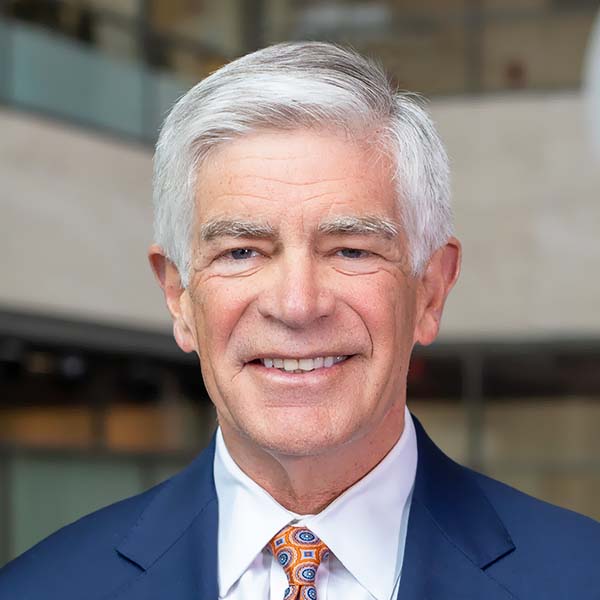Good afternoon! Thank you so much for that introduction. It’s great to be here with this group — and as much as I’d like to have been there in person, it’s pretty great that I didn’t have to fight the traffic on I-95. I’m really looking forward to our discussion today.
My plan is to talk about where we are economically and then to share some of the Philadelphia Fed’s research on housing that I think will be of particular interest to this group. Then we can open things up for a Q&A.
But before we do any of that, I need to give you my standard Fed disclaimer: The views I express today are my own and do not necessarily reflect those of anyone else on the Federal Open Market Committee or in the Federal Reserve System.
Economic Outlook
Maybe it’s the summer weather or the fact that the Phillies are a couple of games ahead of the Nationals in the NL East, but I’m pleased to note that there is a palpable sense of optimism as we convene. (Just kidding about the Nats part!)
COVID-19 cases have fallen to levels not seen since the onset of the pandemic. Deaths are finally retreating as well. After a truly painful 2020 and early part of 2021, things do seem to be turning around.
Throughout the pandemic, the economy has largely tracked the path of the virus. And so as COVID-19 has receded, the economy has picked up. Employment, housing, and manufacturing figures came in stronger over the last couple of months than many of us — myself included — expected.
And recent spending data have once again provided a reminder to never bet against the American consumer. Over the past three months, consumer spending — a component of GDP comprising around 70 percent of the nation’s total economic output — has grown a healthy 2.7 percent.
We’re digging out of a very deep hole — and we have a long way to go — but for now, I’m anticipating national GDP growth to come in around 7 percent for 2021, before moderating to 3 percent growth next year.
There are, of course, downside risks, including vaccination hesitancy that precludes true herd immunity as well as the possibility of new COVID-19 variants that render the vaccines less effective. As encouraging as these trends are, the pandemic is not yet over.
There is no doubt that the cash Congress appropriated to Americans through the Paycheck Protection Program and the more than $3,000 in direct payments to the majority of U.S. households has helped buoy consumer spending during the pandemic.
In some cases, that meant literal cash — one of our contacts who owns a network of gas stations and convenience stores reported needing extra armored car runs during the week that the latest round of stimulus checks arrived to keep up with demand at his ATMs. Here at the Fed, we’re also starting, once again, to deal with increased demand for coins. So I hope there aren’t too many of you who need quarters to do your laundry; it could be challenging for a while to find them …
Other Americans have socked away what they’ve received. The household savings rate is up sharply, and in March, it was at the second-highest rate on record — 27.7 percent. And others are paying down debt at a rapid clip; bankers have told us that there are clearly some who are struggling with loans and forbearance, but that many of their clients are using this period to catch up on payments they may have fallen behind on.
All of this is setting the table for a recovery that could be long and durable.
Now, it’s very important to note that the recovery in GDP has so far outpaced the rebound in the labor force.
The level of employment is still more than 8 million below the prepandemic peak, and that doesn’t account for the roughly 200,000 in monthly gains we probably would have seen without COVID-19. So in a sense, we’re really down around 11 million jobs.
As the economy continues to reopen, I expect job creation to pick up in the coming months. Given current trajectories, I anticipate the labor force returning to its prepandemic trend sometime next summer — it will be a while, in other words.
There are myriad reasons that the employment rebound is slightly lagging other indicators.
Some are salutary: During the pandemic, firms became more productive and learned to do more with less. A more productive economy benefits all of us in the long run.
But what’s puzzling at first glance is that the number of job openings is actually very high. We’ve all seen the Help Wanted signs popping up just about everywhere. And I was just down at the Jersey Shore and had a chance to chat with the manager of a local grocery store. She told me she’s having a hard time finding anybody to work this summer.
What accounts for this? We’ve heard from many employers who say that enhanced unemployment benefits are keeping workers at home. If that’s truly a determinative factor, it will be short lived; the extra benefits expire in September.
Other people may have some hesitancy about returning to the workplace until they get vaccinated and until they’re convinced their coworkers are vaccinated. In my District, I know that many people who commute by mass transit are hesitant about getting back on the bus or train.
And another factor that has driven far too many talented people out of the workforce during the pandemic is a dearth of childcare options.
There is a real economic cost that all of us incur when people — and let’s be frank, mostly mothers — leave the labor force because they can’t find an affordable option for taking care of their kids during the workday.
In Delaware, for instance, it now costs the median-earning family 20 percent of their income to pay for the care of a child under 5 years old. That’s a heavy burden — even before COVID-19 shuttered many schools and childcare centers, further straining families.
Making childcare more affordable is a complex issue but one that surely requires our attention. Already, one of the most oft-cited reasons couples give for having fewer children than they say they want is the cost of raising them.
My colleagues at the Minneapolis Fed have found that, at the outset of the pandemic, many parents of young children left the labor force — 3.4 percent of fathers and 2.9 percent of mothers dropped out altogether. But in the ensuing year, most fathers have returned to the labor force, while the participation rate of mothers of young children is still down 2.8 percentage points from before the pandemic. That is a lot of human capital lying untapped.
Inflation and Fed Policy
With the economy picking up and so much fiscal support and monetary accommodation, there is some upside risk to increased inflation. We will continue to monitor that closely. But for now, I’m forecasting close to 3 percent headline inflation for 2021.
At the Fed, we’re planning to keep the federal funds rate low for long, but it may be time to at least think about thinking about tapering our $120 billion in monthly Treasury bond and mortgage-backed securities purchases. This is not something we are going to do suddenly, though. We need to follow the playbook we had after the Great Recession; that is, start to taper the bond purchases slowly. We will remove accommodation carefully and methodically as the economy continues to strengthen.
It may not make for exciting speeches, but our goal here is to be boring.
Research on Forbearance
Now, before we move to the Q&A, I would like to share some research from my colleagues at the Philadelphia Fed.
I’m reminded of the old Saturday Night Live joke about Rhode Island — neither a road nor an island — and I know that not everybody in this group is a woman who works in housing or finance. But I’m sure you’ll find it interesting and important.
My colleagues in Philadelphia wanted to get to the bottom of two important questions as we assess and seek to remedy the damage wrought by the pandemic.
First: What is the extent of racial and income disparities among mortgage borrowers in nonpayment on their mortgages, and how has the pandemic affected these disparities? Then, they wanted to find out who took up forbearance on their mortgages and who missed this important opportunity.
Because the CARES Act mandates that borrowers in forbearance who aren’t paying on their mortgages still be reported to credit bureaus as if they are paying, these turned out to be surprisingly tricky questions to answer. But through some quite clever methods — my Philadelphia Fed colleagues are nothing if not ingenious — the researchers were able to suss out the data.
Here is what they found: Between April and November 2020, minorities’ and lower-income borrowers’ nonpayment rates were twice as high as for higher-income and White borrowers.
Even if we compare borrowers with the same credit score and the same loan type, Black and Hispanic borrowers have more than 30 percent higher rates of nonpayment, and lower-income borrowers 50 percent higher. Moreover, and importantly, these disparities largely did not exist pre-COVID-19.
In a sign that the CARES Act was effective, my colleagues found that minority and lower-income borrowers took up forbearances at significantly higher rates than other groups.
The rub, of course, is that under the CARES Act and subsequent extension from the Biden administration, forbearance lasts only up to 18 months, meaning many borrowers will be coming off soon. That’s concerning, given that as of mid-May, about 35 percent of people who went into forbearance in the first place are still in it — an estimated 2.2 million borrowers.
That presents a challenge to borrowers first and foremost, of course. But also to lenders. And my colleagues suggest a possible solution to this problem.
The proposed fix would extend the term of the loan and reduce interest payments, for payment-reduction modifications of 20 or 30 percent in total for those who have a high payment burden and little equity in their house. In the case of a 20 percent reduction, these modifications would cost lenders about $1.5 billion. For 30 percent reductions, the cost would be $4.3 billion.
The upshot? Only a fraction of the costs of broader government-assistance programs enacted in 2020 and 2021 could keep distressed borrowers in their homes. That strikes me as something worth thinking hard about.
So, thank you again for having me, and now I’m happy to take some questions.
- The views expressed here are the speaker’s own and do not necessarily reflect those of anyone else in the Federal Reserve System.

